“DR. SEUSS” ON A CLINTON HILL BROWNSTONE
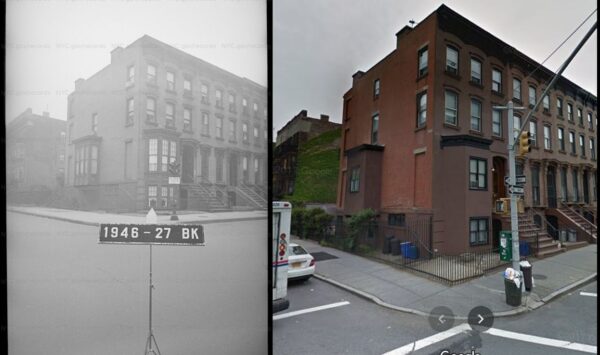
******************************************************************************************************************************** Brownstone Detectives investigates the history of our clients’ homes. The story you are about to read was composed from research conducted in the course of one of those investigations. ******************************************************************************************************************************** What happened here, It is not clear. Some window bays Have lost their glaze. I wonder why They had to nix it. For it wern’t broke, So t’wern’t to fix it. – Dr. Seuss, on the bay windows of No. 280 Lafayette Ave, Clinton Hill, Brooklyn. Follow @BrownstoneDetec Share ———————————————————————————————————————– The Brownstone Detectives Brownstone Detectives is a property research agency. Our mission is to research, document, and save the histories of our clients’ historic properties. From this research, we produce our celebrated House History Books. Each book is fully cited, featuring detailed narratives and colorful graphics, and is designed to bring the history of any house to life. Contact us today to begin discovering the history of your home.
THE PAINTED LADY OF SACKETT STREET (1958)
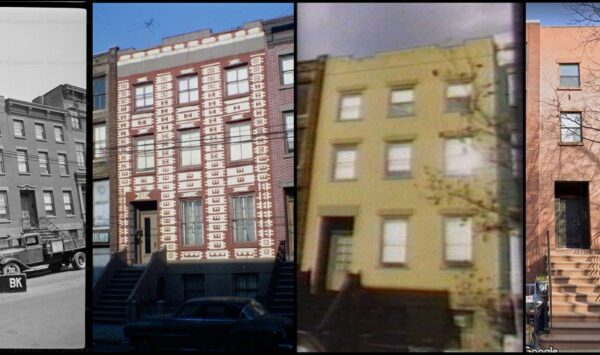
******************************************************************************************************************************** Brownstone Detectives investigates the history of our clients’ homes. The story you are about to read was composed from research conducted in the course of one of those investigations. Do you know the history of YOUR house? ******************************************************************************************************************************** Houses as old as the historic brownstones of New York City have had a lot of time to experience change – change of ownership, change of status, as well as physical change. Much of that change often occurs on the inside of these buildings as their occupancy type changes. The most prevalent change of this type that occurs over time is the change of a property from a single family house to a mutiple dwelling or boarding house. Just outside the Cobble Hill Historic District, sits a much-altered brownstone on Sackett Street between Court and Clinton Streets, No. 275. Constructed pre-1855 as a one-family house it would experience many change over the years. Its original address was No. 160. Its original owner appears to have been William H Perry, a stock broker on Wall Street. By the 1860s, the Forsyth family lived in the Sackett Street rowhouse. Orlando Forsyth was a jeweler who, in the 1840s, had had a showroom on Fulton Street at No. 99. The house would begin taking boarders in the 1870s, continuing at least through most of the 20th century. THE LADY GETS A FACELIFT At face, however, the physical changes of No. 275 seem to be the most striking. While, in its original state, it resembled […]
BODY-BUILDING IN THE GOWANUS (1911)
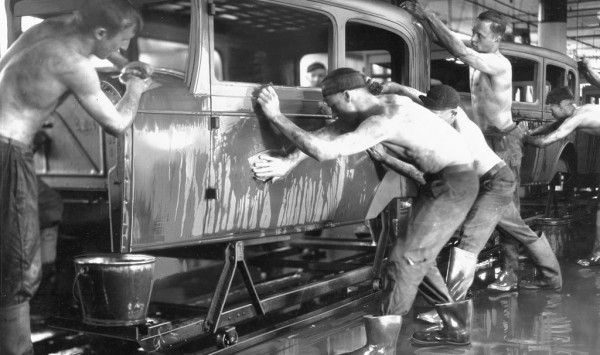
******************************************************************************************************************************** Brownstone Detectives investigates the history of our clients’ homes. The story you are about to read was composed from research conducted in the course of one of those investigations. Do you know the history of YOUR house? ******************************************************************************************************************************** Brooklyn’s Third Avenue was always just a bit gritty – even before the city decided it needed a motorway there to help ease congestion. That was when it started construction on the Gowanus Expressway in 1939. Traffic, though, had always been a large part of the avenue’s make-up. Even before the motorized vehicles, there were the horse-driven vehicles – cars, vans, streetcars, &c. But it was not just the vehicles that motored along the road that gave Third Avenue its rep – it was also those that parked alongside it – on lots, motor pools, parts yards, and other commercial properties. DONIGAN & NEILSON: BODY-BUILDERS One company that fit perfectly into its surroundings was Donigan & Neilson at 743-747 Third Avenue. This partnership’s firm catered to those commercial companies that operated using a variety of vehicles – to deliver, to haul, to move, &c. Donigan & Neilson built the bodies for those commercial vehicles – designing, building and assembling the bodies for hacks, trucks, vans, delivery wagons, and the like. This, of course, was before the assembly-line manufactured truck, when it made sense to have a commercial truck body made to order. According to their advertising, Donigan & Neilson began operations in 1875, when only horses propelled vehicles, and they were […]
THE CHANGING FACE OF MACON STREET (1908)
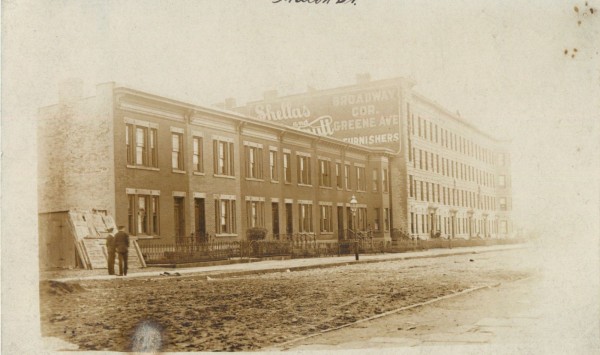
******************************************************************************************************************************** Brownstone Detectives investigates the history of our clients’ homes. The story you are about to read was composed from research conducted in the course of one of those investigations. Do you know the history of YOUR house? ******************************************************************************************************************************** While researching the history a local brownstone, we located an old postcard of a street in Bedford-Stuyvesant. The sepia paper photograph gives an idea of the innate promise of the neighborhood back in 1908 as it was still being built up with new brownstones, limestones, and rowhouses. That picture postcard, featured above, shows a stretch of Macon Street – replete with newly built rowhouses – that starts at the back of the Saratoga Library on Thomas S. Boyland Street (then, it was Hopkinson Avenue), and ends about halfway down the block before reaching a row of barrel-fronted 2-family houses and the one-time parking garage at the corner of Saratoga Avenue (now the Shirley Chisholm Day Care Center). Interestingly, this part of Macon Street still had its dirt (mud on rainy days) street as late as 1908. Residents of the area had been complaining to the City of Brooklyn (by 1908, the borough of Brooklyn) since the 1890s about the slow pace of street paving in the district. Home building had gone on at such a fast clip during this period that the city had struggled to keep up with the builders. The houses that are the focal point of the snapshot were the first put up on the block – what […]
HOW ART DECO CAME TO PARK SLOPE (1931)
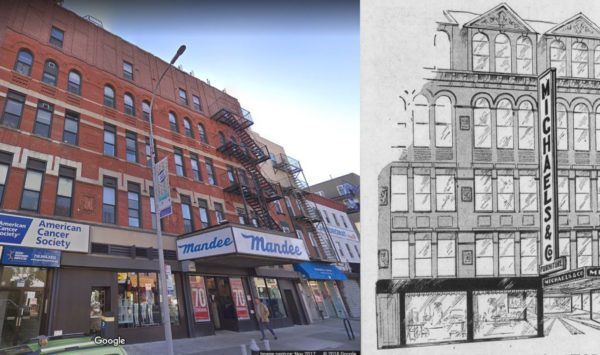
******************************************************************************************************************************* Brownstone Detectives investigates the history of our clients’ homes. The story you are about to read was composed from research conducted in the course of one of those investigations. Do you know the history of YOUR house? ******************************************************************************************************************************* Up until the 1930s, everything in Park Slope was Victorian brownstone. But then came Michael’s and the revelation of a stunning Art Deco facelift. ART DECO IN THE HOUSE For those of you familiar with 5th Avenue in Brooklyn, you may be acquainted with the 5-story building with storefronts known as Nos. 503-505. Currently housing Urban Market of Park Slope, the entire floor was at one time taken over with bedroom sets, kitchen tables, and dinettes – a furniture store known as Michael’s & Co. Originally, the building – sitting between 12th and 13th streets – had quite a different look – a product of the Queen Anne/Romanesque architectural period in the late 1800s, its top floor was lined with faux gables and a mansard roof. By the 1930s, a vertical sign and a marquee had been added to the facade, both with the Michael’s name. Today, of course, Michael’s is no more and all of the Victorian architectural features toward the top of the building (as well as the Michael’s signs) have been removed – probably as much out of an extreme aversion to the cost of maintaining such a facade as due to some of extreme economic periods the building’s passed through. Nonetheless, its current facade is rather unremarkable, […]
BOERUM HILL TIMEWARP! (1922 vs. 2018)
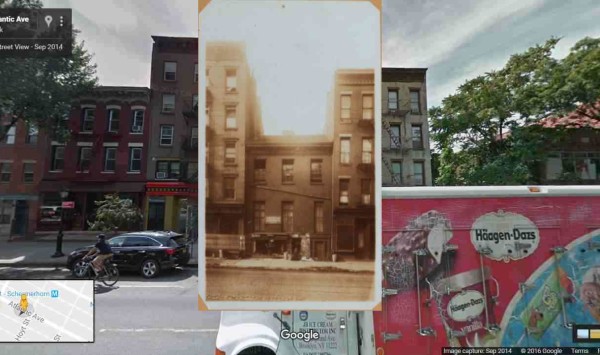
******************************************************************************************************************************** Brownstone Detectives investigates the history of our clients’ homes. The story you are about to read was composed from research conducted in the course of one of those investigations. Do you know the history of YOUR house? ******************************************************************************************************************************** It’s always a blast to compare old photographs of Brooklyn streets with what is there now. Often the old buildings, street lamps, and flagstone sidewalks are long gone, but sometimes you are discover a treat that makes the journey worthwhile. With a little help from the internet it’s easy to make these comparisons and then to even bring the past back to life. Using the Old NYC app, which allows you to search a map of the city to find locations where old New York City pictures were taken (and are stored at the New York Public Library’s Digital Collections), you can search for any address within the five boroughs. With some luck you might find an actual picture of the building or location you are looking for. With our case, we were looking for street addresses on Atlantic Avenue. Searching the database, we found 336 Atlantic Avenue. The picture was described as “336 Atlantic Ave., south side, west of Hoyt Street,” and this particular photograph had a little more information than you usually get on this site – information on the building’s conveyance from one owner to the next, likely around 1922. The caption at the library’s site further notes that the photograph showed “a home bought by Mrs. Pruize […]
THE WHITE ELEPHANT OF AVENUE “O” (1914)
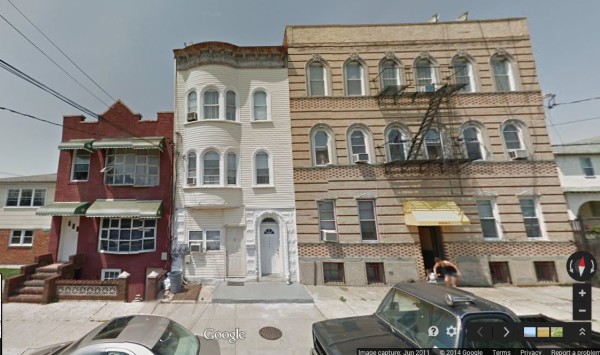
******************************************************************************************************************************** Brownstone Detectives investigates the history of our clients’ homes. The story you are about to read was composed from research conducted in the course of one of those investigations. Do you know the history of YOUR house? ******************************************************************************************************************************** We came across an old newspaper photograph from 1914, republished 30 years later in an old newspaper in 1954. This picture not only celebrates our first entry for a house in the Flatlands section of Brooklyn, but it specifically illustrates a “long-familiar landmark in Old Flatlands.” So noted the text accompanying the picture in the Old-Timers section of the Brooklyn Daily Eagle from May of 1954. Having stumbled across this interesting picture, we were curious to learn if the 2-story and basement structure in question – No. 5407 Avenue O, Brooklyn – was still there, and, by the way, if it was still “white.” So, we looked the address up on Google Maps, expecting to find a shopping mall or a 1940s era soap factory, and – miracle of miracles – there it was! There is a “newer” house to the left of it now, and it seems to have been faced with some vinyl siding (yes, white), but the house appears to be largely as it was back in 1914. The story accompanying the pic in the 1954 article reads as follows: “THE OLD WHITE ELEPHANT”-This picture, taken in 1914, shows a long-familiar landmark in Old Flatlands located at 5407 Avenue O.” COMPLETE FAMILY “The Di Carlo family is shown. […]
THE CHANGING FACE OF A STOOP (1921)
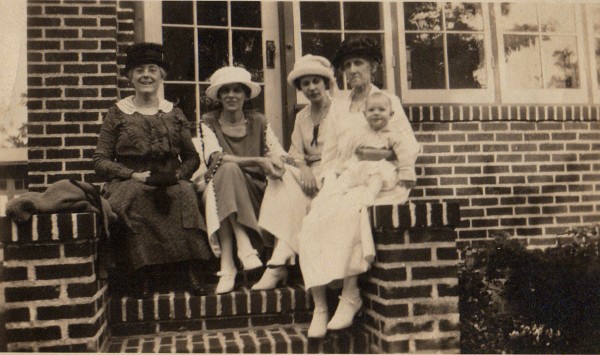
******************************************************************************************************************************** Brownstone Detectives investigates the history of our clients’ homes. The story you are about to read was composed from research conducted in the course of one of those investigations. Do you know the history of YOUR house? ******************************************************************************************************************************** In 1921, the Nilsen family purchased their Bay Ridge home at 8719 Colonial Road. Immediately, it seems, they began to document a lifelong record of their family’s generations, all surrounding one of the more iconic features attached to a Brooklyn home – their stoop. With a fascinating collection of photographs arranged in a chronological order, Bonnie Nilsen – whose father, Frank, is in most of the photographs – laid out her family’s record of life on the stoop of the original Nilsen family home. (The original record – along with Bonnie’s other photographs – can be seen at her website, BonnieNilsen.com.) In the meantime, though, we’d like to share a few of the more “stoop-central” photographs below. (See if you can spot the changes over the years.) Follow @BrownstoneDetec Share ———————————————————————————————————————– The Brownstone Detectives Brownstone Detectives is an historic property research agency. Our mission is to document and save the histories of our clients’ homes. From our research, we produce our celebrated House History Books and House History Reports. Contact us today to begin discovering the history of your home.
HAS YOUR BROKER BEEN FOOLING YOU? (1905)
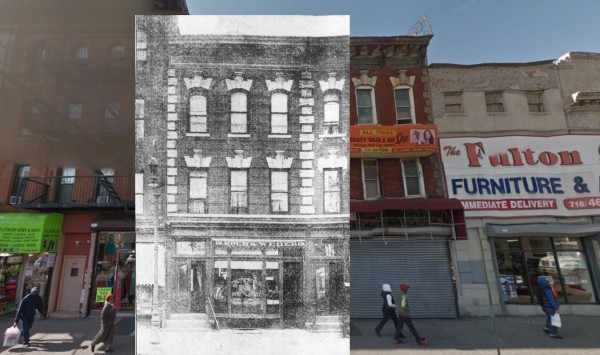
******************************************************************************************************************************** Brownstone Detectives investigates the history of our clients’ homes. The story you are about to read was composed from research conducted in the course of one of those investigations. Do you know the history of YOUR house? ******************************************************************************************************************************** In 1905, No. 838 Flatbush Avenue was only a few years old. But it was already on its third tenant. The Brooklyn Daily Eagle opened its Flatbush office at No. 838 (today, No. 834) that year, forcing Weber & Koch realtors out the door. The building had been constructed by Captain Henry Hoffman. Hoffman, referred to as captain from his sailing days, was the sole surviving member of the crew of the schooner America which had brought the America‘s Cup to the United states in 1851. In business life, Hoffman was a big man in New York society, having been a millionaire coal merchant, though, in 1905, and reputedly (according to many sources – amongst them the Daily Eagle) the wealthiest man in Flatbush at the time. Hoffman had originally expected to use the site for the real estate dealings he dabbled in. Soon after building the structure, however, Hoffman would sell and move on. The new owners would be the borough’s premiere newspaper, the Brooklyn Daily Eagle, which would maintained the office as a branch of the newspaper up until around the late 1920s. In 1918, however, part of the building was taken up by another organization. The Flatbush Chamber of Commerce established itself there. All this from an unassuming […]
WATCHING THE (HOUSE) DETECTIVES…
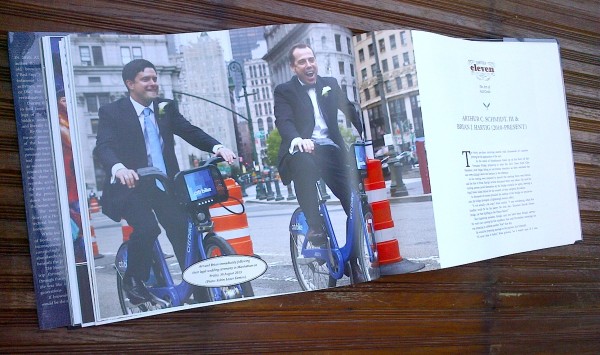
Have you ever wondered about the people who once lived in your house? Where did they sleep? How did they dress? Were they bankers, doctors, carpenters, engineers…? What were the hopes that encouraged them to go on and the secrets that kept them awake at night? Well, if you live at 738 Macon Street in the Bedford-Stuyvesant section of Brooklyn – which is a decidedly very low probability – then you are privy to the answers to these questions. And more. Brownstone Detectives, an historical investigation team, published 738 Macon Street: The Story of a House, a 170-page full color coffee table book laying out the history of the brownstone house at that address. Published in 2014, it was their first book of many others to follow. Since then, they have gone on to publish more than 50 others for homeowners in Brooklyn and Manhattan. And they plan to expand soon to the remaining boroughs and eventually to the tri-state region. Their first book – like the many that have come after it – spanned the ownership of the house for many generations, including the ownership of the land that the house was built on back to the time of the original Dutch settlers. The story is revealed in a manner that seamlessly weaves the individual owners’ stories into one continuous and flowing narrative. Rich, colorful pictures, ancestral documents, newspaper clippings, and architectural records fill the almost 200-page hardbound document. FALLING INTO HISTORY… Brian Hartig, the chief Brownstone Detective, fell […]